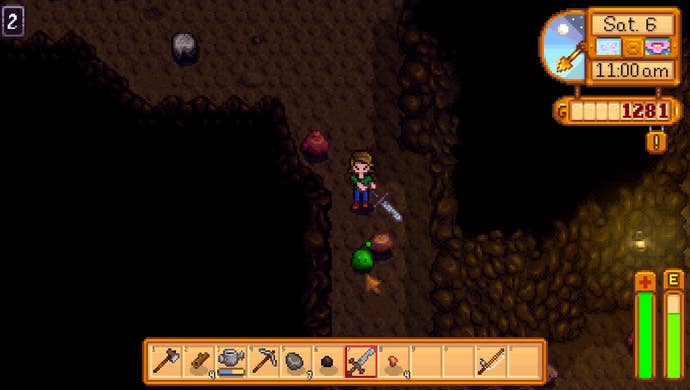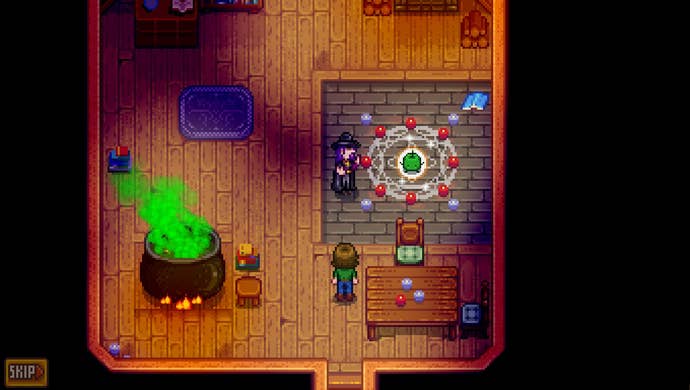With Stardew Valley, Harvest Moon Finally Has a True Successor
ConcernedApe's debut game brings back the lost magic of Natsume's series for the best farm life sim in ages.
This article first appeared on USgamer, a partner publication of VG247. Some content, such as this article, has been migrated to VG247 for posterity after USgamer's closure - but it has not been edited or further vetted by the VG247 team.
Before starting up Stardew Valley for the first time, I asked a friend currently playing it if he had any advice for me. "Yeah," he said. "Clear your schedule."
I walked into Stardew's world with some skepticism, but after my first session ended with five hours on the clock, his slightly ominous words of warning started to make a lot more sense: If you let Stardew Valley get its hooks into you, it'll make a feast of your free time. And, as someone predisposed to liking slow, meticulous games in the vein of Harvest Moon, my friends may need to stage an intervention for me in the coming months.

I'll fully admit I took to Stardew Valley so quickly because I've been consistently disappointed with Harvest Moon since the series started moving in strange directions following 2003's Friends of Mineral Town. While the games leading up to that Game Boy Advance release smartly built off of what came before, the Harvest Moons to follow amounted to scattershot approaches that sometimes worked, but mostly didn't. Above all, these later Harvest Moon games forgot what made the first handful of iterations so much fun: Following some extremely minor tutorials, you're given free reign to tame the land as you see fit, and gradually whip your gnarly farm into shape. No matter how many times Harvest Moon tries to reinvent itself, the series has consistently left this focus on freedom by the wayside, and instead chooses to gate everything to ensure the player isn't overwhelmed. The intentions are good, but this tack usually means every Harvest Moon game rolls out with 30 in-game days of pointless, chatty tutorials, explaining the most basic of actions in excruciating detail.
So it was more than refreshing to boot up Stardew Valley and be given complete control after just a few minutes of setup. It helps that I'm so familiar with its inspiration, of course, but the idea of turning a dilapidated farm around in three years shouldn't strike anyone as alarmingly complex. That's not to say Stardew Valley isn't prepared for the confusion of newcomers, though its tutorializing doesn't disrupt the experience: As you play, you're given a variety of quests the subtly teach you how to play the game by tasking you with taking different actions. If you're a Harvest Moon veteran, you'll reap the rewards of these quests by doing what comes naturally, but those new to the world of farming sims can take on these tasks more directly to learn about how Stardew Valley's various systems function. In any case, Stardew teaches through play rather than sheer explanation, which should be mandatory for every video game.

Admittedly, Stardew isn't shy about aping its inspiration—it's essentially Harvest Moon with the serial numbers filed off. But it's definitely much more than a thoughtless rip-off: As someone familiar with the series, I can sense the creator of Stardew definitely took a look at Harvest Moon and made a serious attempt to speed up everything that's not supposed to be slow. Stardew features the same strange joy of waiting several in-game days to harvest a field of cauliflower, but basic actions like picking up/using items and sorting through your inventory no longer require those needless, tedious extra steps. In a move that feels slightly inspired by Minecraft, resources you discover in the world through actions like breaking rocks and chopping weeds now automatically get sucked into your inventory—which really cuts down on the tedium of having to pick up everything individually. Stardew contains Harvest Moon's "doing your homework" sense of gradual, earned rewards, but not having to constantly fight the UI makes the path to said rewards all the smoother.
And, as with any good game in the Harvest Moon mold, Stardew features more than enough stuff to do, and nearly not enough time to do it in. While having a general game plan for any day's waking hours stands as an excellent basic strategy, the quests (and requests from villagers) do an excellent job of nudging you in the right directions—and getting you to try some activities you might not have discovered on your own. Your first few days might entail some basic farm maintenance, but soon you'll discover fishing, mining, animal husbandry, fighting monsters, foraging, and several other tasks to test how much you can make of your day. Add in the socializing necessary to get to know (and eventually wed one of) Stardew Valley's cast of quirky weirdos, and the experience comes dangerously close to the stress of real-life time management. Unlike reality, though, Stardew's world is a friendly meritocracy where hard work always pay off.

When playing the last 4 or 5 Harvest Moons, I consistently thought, "Man, I wish I could have sat in on development and slapped the hand of the developer who thought this was a good idea." Stardew Valley's one-man-band known as Eric Barone took this urge and actually did something productive with it by going off and making his own game. Granted, it might not be the most original creation out there, but Stardew features a surprising amount of thoughtfulness behind each and every one of your actions, making it easy for hours and hours to slip by without a single moment of frustration. I'm definitely sensing the beginning of what could be the beginning of a dangerous addiction, but after being starved of some good Harvest Moon-ing for so long, It's good to be off the wagon again.








